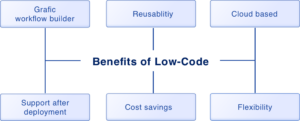Low-Code: What it is and How it Works

What if all apps and systems could be integrated into a data warehouse without any programming knowledge? Or all of a company’s invoicing would run automatically via the ERP? With low-code integration platforms, that is no longer a problem anymore. How it works and why a low-code development platform can take a company to the next level is explained in the following article.
Content
1. Definition of low-code
Low-code generally means a simple creation of a software that requires little to no programming.
Instead of using complex programming languages, functions can be configured or apps created with the help of so-called Graphic User Interface (GUI), using drag and drop. With this intuitive technology, mobile apps or even business software can be created – without programming knowledge.
“By 2025, 70% of new applications developed by enterprises will use low-code or no-code technologies, up from less than 25% in 2020.” (Source: Gartner)
2. What is a low-code platform?
A low-code platform is a software development environment in which different apps and systems can be connected with each other by using visual components via drag and drop – without any programming knowledge. It does, however, require everyone involved to be willing to learn and adapt to the new technology.
Low-code platforms usually offer the following elements:
- Drag and drop function
- Forms
- Workflows
- Data models
- iPaaS integrations
- Embedded white label integrations
- Dashboards and reports
The developers are provided with a standardized modular system. They can then use the Graphic User Interface (GUI) to put together the requested apps and applications using drag and drop as required. In this way, up to 80 percent of all programming is already covered.
This leads to significant time and cost savings, which can lead to a 10-fold increase in productivity. In addition, the company remains flexible compared to no-code, because individual user-defined changes are still possible without complex deploy processes.
Low-code integration platforms are provided by various software vendors for an annual or monthly license fee. License fees can vary greatly depending on the low-code platform provider. Ideally, there is a monthly fixed price with no add-ons.
3. All advantages of low-code platforms at a glance
3.1 Graphical Workflow Builder
As mentioned, using graphical modeling tools, companies can build their applications using a drag and drop interface. This tool provides a graphical interface that makes it easy for users to design and configure the arrangement they want.

3.2 Reusability
One of the key benefits of low-code development is the code and component reusability. This means that the components of the code have to be created only once or bought from a low-code service provider. Afterwards they can be reused in multiple places in the application and customized if needed.
This saves a lot of time and effort and helps to ensure consistency throughout the application. Hence, work processes are optimized and the maintenance effort is reduced, at the same time productivity and quality are increased immensely.
3.3 Cloud-based Access
An equally essential advantage of low-code platforms is the access via cloud.
This makes it possible to work on projects regardless of location. In addition, the cloud-based access facilitates the collaboration of teams from different departments on projects. If a new database is used or the cloud is changed, no more time-consuming programming is necessary.
At Locoia, the software is hosted on secure AWS servers.
The servers and thus your data are located in Germany with an availability of 99.99%
3.4 Post-Deployment Support – Low-Code as a Service
Low-code platforms also offer support after the development phase or after deployment. This support may take the form of platform updates, advice on implementation, deployment and maintenance of the application, or troubleshooting problems.
Low-code integration platforms as a service are hosted by the provider and accessed via a web browser without having to install them on their own servers.
3.5 Cost savings
Because up to 80% of the programming effort is already covered, a company saves considerable IT costs.
3.6 Flexibility
Compared to no-code, low-code is flexible because individual custom changes are still possible without complex deploy processes.
If you are looking for a way to speed up your application development process, low-code is definitely the best choice. Contact us today to learn more about our low-code integration platform and how it can benefit your business.
All advantages at a glance:

4. Who is low-code for – target group
Since low-code platforms do not require any programming knowledge, they address a much larger target group:
- Citizen Developer (technically experienced employees without programming knowledge)
- Power User
- Database Managers and Administrators
- Business Analysts
- Programmer
The size of the company does not matter, from technical start-ups to normal medium-sized companies to large corporations, low-code platforms can offer significant added value.
It is important to mention, that low-code development is particularly well suited for workflows and recurring routines. Very complex and demanding software products still have to be handled by professional programmers.
According to a report by Gartner low-code integration platforms are particularly suitable for companies that need the following criteria:
- High Performance
- High availability and scalability
- Disaster Recovery
- Enterprise Security
- API access to and from enterprise and third-party cloud services
- Application usage monitoring
- Service Level Agreements (SLAs)
- Technical support and training provided by the provider
Please note: the more extensive and organized the access of the low-code platforms to data and interfaces is guaranteed, the greater the radius of action of the low-code tool.
In order to exploit the advantages of low-code development platforms, an understanding of day-to-day business and the existing software programs and databases is also required.
Typically, most software vendors provide in-depth video tutorials or training to support the appropriate teams.
5. The use of low-code development in companies – examples
- Business process automation
- Invoicing directly from the company’s CRM
- Issue an NDA (Non Disclosure Agreement) with just one click
- Sync ERP system to CRM
- ERP: Automatic reordering of delivery parts
- Workflow: Tools that use artificial intelligence can be connected. For example classification analysis for images or texts
Interested? More examples of workflows can be found here.
6. The most important factors for choosing the right low-code platform
The many low-code applications on the market sometimes differ significantly in their solution approaches. When selecting the right one, the following criteria should be considered in order to reap the maximum benefit for the company:
The software vendor should enable following features:
- One step deployment, execution and management (Gartner)
- Automation and management of complex business processes (Gartner)
- iPaaS and SaaS integrations
- AI-assisted development techniques (Gartner)
- Composition of applications (Gartner)
- Embedded white-label solutions
- Meet appropriate compliance and security requirements
- GDPR compliance
- Dashboards and reporting
- Overall customer satisfaction
7. Summary and conclusion
The advantages of low-code development are quite obvious. However, in order to be able to use them sufficiently, the relevant teams must be willing to learn – something that most companies nowadays take for granted anyway.
The concern that some of the employees lack skills for digitization is completely unjustified with low-code. The intuitive graphic user interface makes it possible for employees who are not digitally savvy to operate and use it – without support from the IT department.
Sooner or later, the term low-code will become indispensable for successful companies.
Increase in efficiency through process automation
Locoia integrates your apps & systems into a uniform data warehouse
